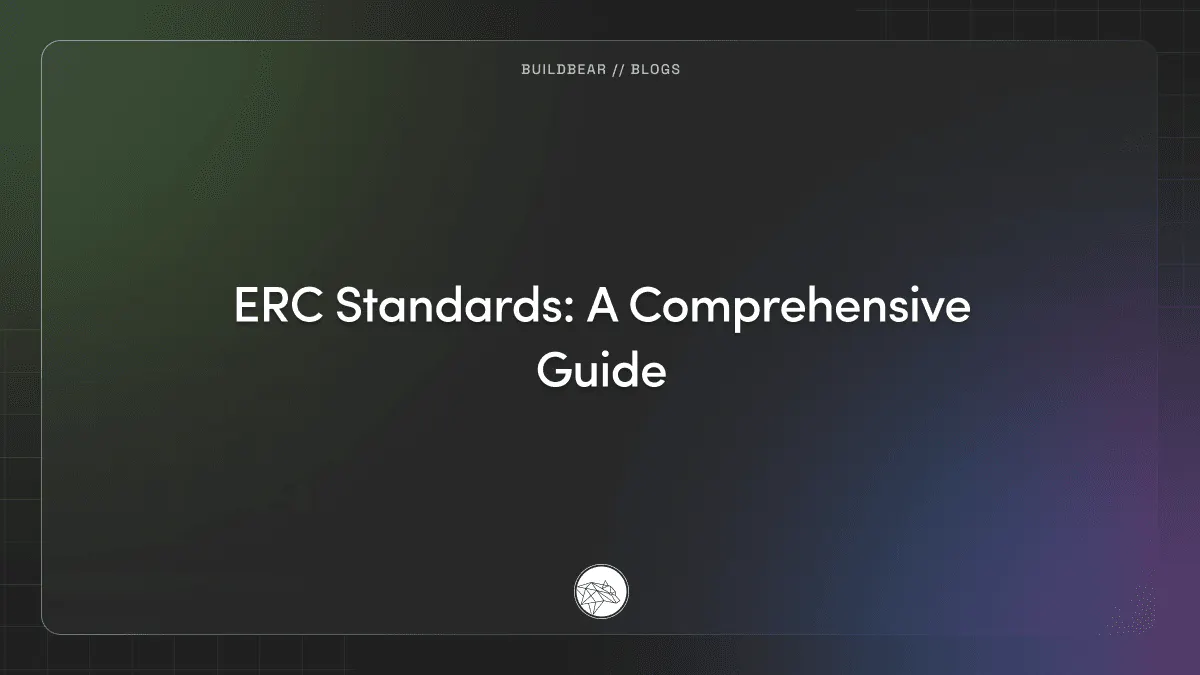ERC Standards: A Comprehensive Guide
 BuildBear
BuildBear
This article was first published on the BuildBear website at https://www.buildbear.io/blogs/ERC_Standards.
What are ERC standards?
ERC stands for "Ethereum Request for Comments." These are essentially sets of technical guidelines that define how smart contracts, the building blocks of Ethereum applications, interact with tokens. Think of it like a universal language for tokens, ensuring seamless communication and interoperability within the Ethereum ecosystem.
Why are ERC standards important?
Imagine a world where every token spoke its own dialect. Communication would be a nightmare! ERC standards solve this by establishing common rules for token behavior. This fosters:
Compatibility: Wallets, exchanges, and other applications can easily interact with tokens adhering to the same standard.
Security: Standardized functionalities minimize vulnerabilities and ensure predictable behavior.
Innovation: Developers can build upon existing standards, accelerating the creation of new and exciting applications.
Interoperability: ERC standards ensure seamless interaction between different applications and wallets within the Ethereum ecosystem. No more struggling with incompatible tokens!
Transparency: The public nature of ERC standards allows for easy auditing and verification of token functionality, fostering trust and transparency within the ecosystem.
Popular ERC standards:
ERC-20
ERC-20 is a technical standard that defines how tokens are created and managed on the Ethereum blockchain. It's essentially a set of rules that developers follow to ensure their tokens are compatible with other applications and wallets. ERC-20 allows for the creation of fungible tokens. Imagine them like digital dollars, where each one is identical and interchangeable. This makes them perfect for use as cryptocurrency, utility tokens (providing access to services or platforms), or even stablecoins (pegged to real-world assets).
Key features of ERC-20:
Fungibility: Each token is identical, meaning any one can be exchanged for another of the same type. This makes them ideal for use as currency or for representing fractional ownership of an asset.
Transferability: Tokens can be easily sent and received between wallets or exchanged on platforms that support them.
Transparency: All transactions involving ERC-20 tokens are publicly visible on the Ethereum blockchain, providing a high level of transparency and security.
Interoperability: ERC-20 tokens are compatible with a wide range of Ethereum-based applications and services, creating a vast ecosystem for their use.
ERC-721
ERC-721 is a set of rules for creating and managing non-fungible tokens (NFTs) on Ethereum. Unlike fungible tokens like ERC-20 (think of them like identical coins), each ERC-721 token is unique and irreplaceable, making them perfect for representing digital collectibles and other one-of-a-kind assets.
Key features of ERC-721:
Uniqueness: Each token has a unique identifier that differentiates it from all other tokens, making it truly one-of-a-kind.
Ownership: Ownership of an ERC-721 token is tracked securely on the Ethereum blockchain, providing a transparent and tamper-proof record.
Transferability: Tokens can be easily transferred between wallets and marketplaces, enabling trading and ownership changes.
Metadata: Additional information about the token, such as its creator, description, or properties, can be stored in the token itself.
ERC-1155
Imagine a single contract that can manage both your daily currency (like ERC-20) and your prized collection of digital art (like ERC-721). That's the magic of ERC-1155. It allows for the creation and management of both fungible and non-fungible tokens within the same smart contract, offering a streamlined and efficient approach.
Key features of ERC-1155:
Multi-token support: One contract can manage multiple token types, reducing development and maintenance overhead.
Fungibility flexibility: Create fungible tokens (like game currency) and non-fungible tokens (like unique in-game items) within the same contract.
Batch transfers: Transfer multiple token types with a single transaction, saving gas fees and improving efficiency.
Enhanced functionality: Supports additional features like metadata and URI schemes for richer token representation.
ERC-223
ERC-223 is an Ethereum token standard proposed as an improvement upon the widely adopted ERC-20 standard. It aims to address some of the limitations of ERC-20 and introduce additional features for enhanced security and efficiency. Here's a breakdown of what it is and how it works:
What are the main features of ERC-223?
Safer token transfers: ERC-223 introduces a notification system that informs the receiver contract about an incoming token transfer before it's completed. This helps prevent issues like lost tokens due to incompatible contracts.
Improved data handling: ERC-223 allows sending additional data alongside the token transfer, enabling richer interactions between tokens and smart contracts.
Reduced gas usage: Certain optimizations in ERC-223 transactions can potentially lead to lower gas fees compared to ERC-20 transfers.
Backward compatibility: While offering new features, ERC-223 remains compatible with the core functionalities of ERC-20, allowing existing wallets and exchanges to support it without major modifications.
ERC-777
ERC-777 is a relatively newer but increasingly popular token standard on the Ethereum blockchain. It builds upon the foundation of ERC-20, offering several additional features and functionalities that enhance security, flexibility, and transaction efficiency. Here's a breakdown of what ERC-777 is and how it works:
Key Features of ERC-777:
Granular control: Allows for sending tokens with optional data attached, enabling additional use cases like notifications, restrictions, and conditional transfers.
Enhanced security: Introduces features like operator approval and hooks for custom logic, improving control over token transfers and mitigating risks.
Flexibility: Supports both fungible and semi-fungible tokens within a single contract, providing greater flexibility for developers and users.
Interoperability: Remains compatible with existing ERC-20 infrastructure, allowing for seamless integration with wallets and exchanges.
ERC-1337
ERC-1337 is a technical proposal that outlines a standardized way for developers to create and manage subscription-based smart contracts. These contracts would allow users to easily sign up for recurring payments, granting them access to desired services or content for a predetermined period.
Key features of ERC-1337:
Recurring payments: Users can sign a single transaction authorizing automatic payments for a specified duration, eliminating the need for manual payments every month or year.
Flexibility: Developers can define custom subscription models with varying durations, pricing tiers, and cancellation options.
Security: Transactions are recorded on the Ethereum blockchain, ensuring transparency and immutability of payment data.
Decentralization: Subscriptions are managed directly on the blockchain, eliminating reliance on centralized payment processors.
ERC-4626
Think of ERC-4626 as a blueprint for creating smart contracts that act as vaults for your yield-bearing tokens. These vaults automatically handle the complex tasks of interacting with various DeFi protocols to maximize your yield, while still giving you control over your underlying assets.
Key features of ERC-4626:
Vaulted assets: Deposit your yield-bearing tokens (e.g., LP tokens) into the vault and receive shares representing your ownership.
Automated yield generation: The vault interacts with various DeFi protocols, like lending pools and yield aggregators, to optimize your returns.
Transparency: All transactions and holdings are transparently recorded on the blockchain.
Security: Vaults are built with security best practices in mind, minimizing risk of loss or exploitation.
Interoperability: ERC-4626 vaults are compatible with various DeFi platforms, enabling easy integration and switching between strategies.
ERC-725
ERC-725, also known as the "Identity Standard for the Ethereum Blockchain", is a proposed standard that aims to establish a unified way for managing and representing identities on the Ethereum blockchain. It's a complex concept, so let's break it down:
Key features of ERC-725:
Privacy: Users can control what information they share and with whom, improving privacy and security.
Security: Identity data is stored on the blockchain, making it tamper-proof and resistant to manipulation.
Efficiency: ERC-725 can streamline identity verification and authentication processes across various applications.
Innovation: The standard can pave the way for new applications and services that leverage decentralized identity solutions.
ERC-1400
ERC-1400 is like a toolkit for building super-flexible and powerful tokens that can do more than just be exchanged. They can represent real-world assets, manage their own mini-economies, and even interact with other parts of the blockchain ecosystem.
Here are some benefits of using ERC-1400 tokens:
Increased flexibility: You can create tokens with unique features and functionalities tailored to your specific needs.
Enhanced security: The ability to hold other tokens inside your token can improve overall security and control.
Greater efficiency: ERC-1400 allows for automated processes and streamlined interactions between tokens and smart contracts.
Visit https://eips.ethereum.org/erc to learn more about ERCs.
Conclusion
In conclusion, ERC standards play a pivotal role in shaping the Ethereum blockchain's landscape. This standards provide a framework for developers to create tokens that are compatible, user-friendly, and trusted within the broader cryptocurrency community. As the blockchain space continues to evolve, adherence to ERC standards remains essential for fostering innovation and ensuring the seamless integration of diverse tokens on the Ethereum network.
Subscribe to my newsletter
Read articles from BuildBear directly inside your inbox. Subscribe to the newsletter, and don't miss out.
Written by

BuildBear
BuildBear
BuildBear is a platform for testing dApps at scale, for teams. It provides users with their own private Testnet to test their smart contracts and dApps, which can be forked from any EVM chain. It also provides a Faucet, Explorer, and RPC for testing purposes.